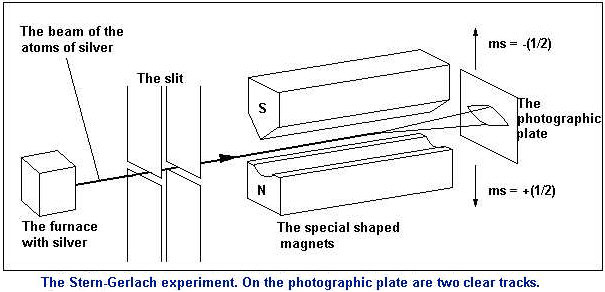Back in the year 1921, almost one hundred years ago, Herr Stern and Herr Gerlach conducted a very intriguing experiment. They heated up silver until it was a gas and they did send the beam of silver ions through an inhomogeneous magnetic field.
They observed the beam splitting into two streams of silver ions, they thought they had found ‘spatial quantization’…
Here is a picture of a schematic set up of the Stern Gerlach expeirment:
 The upper side of the magnetic field is stronger compared to the strength of the bottom field, Stern and Gerlach expected the beam to split in the direction of the gradient of the magnetic field.
The upper side of the magnetic field is stronger compared to the strength of the bottom field, Stern and Gerlach expected the beam to split in the direction of the gradient of the magnetic field.
At present day we know that a beam of electrons also gets split, when three years ago I did read the results from this experiment I was buffled, baffled and bewildered: it was ok by me that a part of the beam went up towards the strongest parts of the magnetic field.
But why was a part of the beam attracted to the weaker parts of the magnetic field?????
This makes no sense, after all in those years I nicely believed electrons were magnetic dipoles because everybody said so. Let me demonstrate in a gedanken experiment why this behavior of the electrons is very strange if electrons are magnetic dipoles:
Begin Gedanken Experiment:
Let an electron cannon send a beam of electrons into an inhomogeneous magnetic field, if electrons are indeed magnetic dipoles in that case you can view them as little vectors. These vectors can point anywhere, together all vectors from a sphere.
Only one of the vectors of that sphere is in perfect anti-alignment with the magnetic field. If we think of the vectors as pointing from the south to the north pole, only the vector that points perfectly south will have perfect anti-alignment.
All vectors that are not perfectly aligned will be pulled into alignment, so if electrons are magnetic dipoles it is expected that almost all electrons will go to the strongest part of the magnetic field.
End Gedanken Experiment.
Yet in practice about 50% of the electrons go up and the other 50% go down…
And I was just puzzled so much; how can the weaker parts of the magnetic field attract magnetic dipoles??? After one or two days I ran the experiment again in my head but at some point I don’t know why I thought ‘Let’s try a magnetic monopole’.
To my amazement a magnetic monopole did give the results as we know them from the Stern Gerlach experiment. And I just thought by myself ‘Hey hey Reinko, not so fast because electrons are not magnetic monopoles but magnetic dipoles. It is even in the Maxwell equations Reinko so think before you speak’.
But a day later I was walking around in the local park thinking about chemical bonds; if electrons were magnetic monopoles that would also explain why we only have electron pairs in chemistry.
Anyway now after three years I have about 40 reasons as why electrons cannot be magnetic dipoles but on the universities where about 100 thousand ‘professional’ physics professors are deployed there is zero reaction to my insights.
On the contrary; they avoid talking about me like I am having the pest…
__________
Back to the year 1927 at the Solvay Conference people like Niels Bohr and Wolfgang Pauli argued that for free electrons it would make no sense to do some kind of Stern Gerlach experiment.
Here is a screen shot of a video I will link below to:
 So five years after the experiment and four years after publication all those guys like the Einstein / Bohr / Pauli / Schrödinger / Dirac / Heisenberg / Bose complex, none of those men understood the basic nature of the electron:
So five years after the experiment and four years after publication all those guys like the Einstein / Bohr / Pauli / Schrödinger / Dirac / Heisenberg / Bose complex, none of those men understood the basic nature of the electron:
An electron is a localization of electrical charge and one of the two magnetic charges.
As such there are two types of electrons: a magnetic monopole north and a south variant.
Also known as ‘spin up’ or ‘spin down’.
The next documentary is about one hour long, if you know nothing about electron spin it is a bit much to swallow in one time. But for me it was a true treasure trove, the guy that gives the talk is eighty years old and has given lectures in quantum physics for decades and decades:
The Stern-Gerlach Experiment And The Discovery Of Electron Spin – Sandip Pakvasa [2016]
Ok I see this post is getting a bit too long so a detailed explanation upon how permanent magnets work is skipped to some future date. In the meantime we have only scratched the surface when it comes to the ‘official version of electron spin’ versus my little set of 40 reasons as why electrons cannot be magnetic dipoles. You can find it in my page on magnetics:
A primer on the electrons that are the long sought magnetic monopoles.
Author: Reinko Venema.
http://kinkytshirts.nl/rootdirectory/just_some_math/monopole_magnetic_stuff.htm#27Oct2015
It is now 23.27 hours and I have more stuff to do in my life so till updates & how permanent magnets work will be dealt with in a new post. (By the way for me it is completely weird and strange that the professional physics people still do not understand permanent magnets. They think the electrons are glued in place…)
Don’t forget to roast the ‘professional’ physics professors with their crazy ideas about electrons.
See yah around.